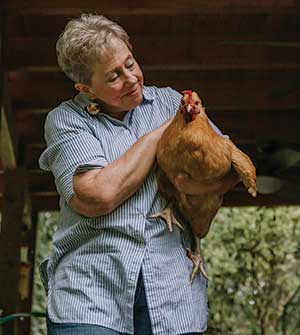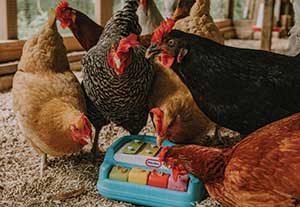
Chickens rule the roost for one Ashville woman
Story by Elaine Hobson Miller
Photos by Mackenzie Free
Some people walk their dogs. A few even walk their cats. Brenda Myers walks her chickens.
“I used to take them on free-range walks, where I’d be the rooster watching for the hawks,” Brenda says. “I only had two hens then, but I have 10 now, and while you can control one or two, you can’t herd 10.”
Now she walks them in chicken “tractors,” the coops-on-wheels that her husband, Dennis, built so the chickens can go for walks without fear of predators. Brenda puts her chickens in one and pulls it with a rope to a grassy spot and lets the flock scratch for bugs and worms. “When they are tired of one place, which is about 30 to 40 minutes, they’ll look at me, and I know it’s time to move them to another spot,” she says.
She treats them more like pets than egg layers. She coos to them, picks them up and strokes them, talks to them as if they were toddlers. She regales her friends with descriptions of their antics. When one was partially eaten by a predator during the night, she cried for weeks. She’s constantly perusing chicken websites for tips and picks up toddler toys for them at thrift stores. To say she’s obsessed might be an understatement.
“Chickens are awesome creatures,” she says. “God just made a good thing when he made chickens.”
Brenda got her first chickens, two six-year-old hens, in January 2021 for the fresh eggs and fun. She had wanted some since first moving to Ashville in 2002, but Dennis kept saying no, they’re smelly. Getting the first two gave her a chance to see whether she liked chickens. She kept them a year before a raccoon got into their coop and ate part of one. The other died of an apparent heart attack just seeing the animal chomp away on her sister. Brenda buried them together.
On her birthday in March of 2021, she got six chicks from the St. Clair County Co-Op in Ashville: two Buff Orpringtons, two Black Orpringtons and two Barred Rocks. They were a day old, shipped from the hatchery at birth. “Of that first six, one was a rooster, and I re-homed him,” she says. “I did not want the drama.” Then she got five more: two Lavender Orpringtons, two Cinnamon Queens and a Black Sex Link. She raised all of them in her basement until they reached laying age, which is five to six months, depending upon the breed.
“I had to separate one, Sandy, because she got picked on,” Brenda says. “But all of them get along fine now.” The flock consists of Verna (named after a friend), Sandy, Bertha, Baby (the runt who rules the roost), Silk, Satin, Cinnamon, Honey, Lacy and Buffy.
Dennis designed the latest coop and tractors. The first coop came with the first two hens, then he built a larger one last fall. The new one measures 9 feet by 31 feet. At one end is the door, while a 4-by-6-foot chicken house is at the other end. The chicken house has beams for the hens to roost on at night, with doors that close automatically behind them to prevent predators from getting to them should they manage to get inside the screened coop. A nesting box with three compartments has its own outside doors so Brenda can gather eggs without going into the coop. The entire setup includes a 27-foot run, which gives the hens some freedom of movement.
Inside the run are wooden perches, a swing, traditional chicken feeders hanging from the rafters and a plastic cat-litter bucket turned into a hanging water bucket with the insertion of “chicken nipples.” The latter are handy little devices that screw into the bucket and release a small amount of water when pecked. There are two old wooden chairs tied together, back to back in the center of the run, and the hens use the combined backs as a perch.
And then there are the toys. There’s a toddler learning box attached to the side of the coop that plays “Old McDonald” and makes farm-animal noises when poked or pecked and two xylophones. She puts peanut butter on the toys to make the chickens peck them. She has taught Sandy to “play” the xylophone using a clicker. She also has a plastic toy caterpillar that plays, “If you’re happy and you know it, clap your hands.” Brenda substitutes “wings” in place of “hands” as she sings along with the toy.
The newest addition to the collection is a child’s bicycle. Dennis removed the handlebars, laid it on its side, and propped it up with a concrete block under each wheel. The idea is for the chickens to hop on the wheels and use them as merry-go-rounds or treadmills. “So far, no luck,” Brenda says, sighing.
She likes to pick up her chickens and pet them, but there’s a trick to that. “If you scratch their backs, they’ll lie down, as if submitting to a rooster’s amorous advances. You can pick them up then,” she says, demonstrating the technique with Sandy.
Their main diet consists of dried mealworms and laying pellets. But she showers them with snacks, too. So, when she approaches their coop, they gather at the door, clucking and pacing in anticipation. They’re carnivores that love bugs, especially ticks, and will eat worms, lizards and mice, too.
They also like milkweed, clover and other grasses, and once ate the burrs off Brenda’s pants after her trek through the woods. She bought some sage plants for them, along with lemon mint leaves. Lots of plants are poisonous to them, though, so she checks the internet before giving them something new. “I check several sources, not just one,” she says. “I’m growing cabbage and collards for them, too. I cut cabbage heads in half and hang them in their coop.” They also like apples, pears, cucumbers, squash, watermelon and cantaloupe. Fresh corn on the cob is their favorite, though. “I didn’t know anything about chickens when I got the first ones,” Brenda says. “I had to learn from scratch (no pun intended).”
She says chickens are a hoot, and they help her relax. She often takes a lawn chair and just sits by the coop, watching them and listening to their coos. “When they’re happy, they purr like a female turkey,” she says, as if everyone knows how a female turkey sounds. “When they’re angry, it’s almost like a honk.” She coos back at them, as if they were human babies. Ask Dennis how he feels about the “smelly” chickens, and he replies, “I built the chicken things, didn’t I?” He likes watching them, too.
Brenda says they’re quite amusing when taking dirt baths. They will lie down and use first one leg and then the other to toss dirt onto their backs and sides. Then they’ll roll over on their sides and spread the dirt and get up and shake like a dog or horse. A certain amount of dirt stays under their feathers, keeping out mites and lice.
Back in early June, Verna, one of the Black Orpringtons, became “broody.” That’s what you call a hen who wants to be a mom so bad she will sit on a nest for days trying to hatch a non-existent egg. “Verna would ruffle up her feathers when touched,” Brenda says. “A lot of people get pecked when they try to handle a broody hen.” A broody one will sit on a nest up to three weeks, even though there is no rooster around to fertilize and no eggs under her. “Sometimes they will die because they don’t eat or drink all that time,” Brenda says.
The best thing she has found to get a broody hen off the nest is to give her “time out.” She yanks her out of the nesting box and puts her into a large dog cage within the coop. She puts food and water in the cage and leaves her there most of the day, returning her to the roost at night. “If you do this about three days, she’ll get the message,” Brenda says.
It’s a challenge keeping the chickens hydrated in the summer. She hoses down a space in their run so they can wallow in it and puts ice in their water bucket. She also gives them cool treats like frozen blueberries.
She gets eight to 10 eggs per day in spring and early summer. “They’ll slow down on hot days, and they molt in the fall and don’t lay as much,” Brenda says. “They don’t lay during the winter.” Ten eggs per day are more than she and Dennis can eat. She gives away some, but she’s also learning to preserve them. Who knew you can keep them up to a year in a jar with pickling lime and distilled water?
“You need the freshest eggs possible,” she says. “They can’t be older than three days. You don’t wash them but leave the bloom on. It’s an antibiotic.” (The bloom is a foamy layer of protein that surrounds the egg and is the last thing formed on the shell before it is laid, according to Chicken Whisperer magazine).
Brenda preserves them in a gallon glass jar that holds 30 eggs. She stores the jars in her basement. “If you don’t want to preserve them, you can leave fresh eggs on your countertop for five weeks unwashed or you can wash them and place them in the refrigerator for three months,” she says. “Store-bought eggs won’t keep that long.”
While other people are pulling up photos of their grandchildren on their cellphones or posting them on Facebook, Brenda is pulling up photos of her chickens. “They’re my grandchildren,” she says.

















